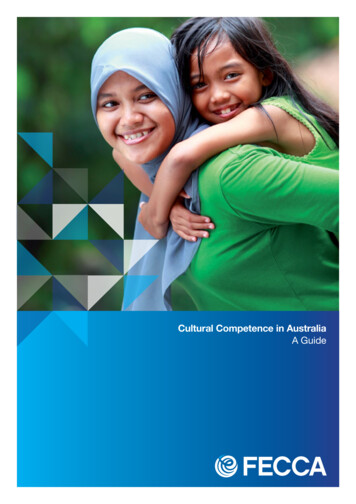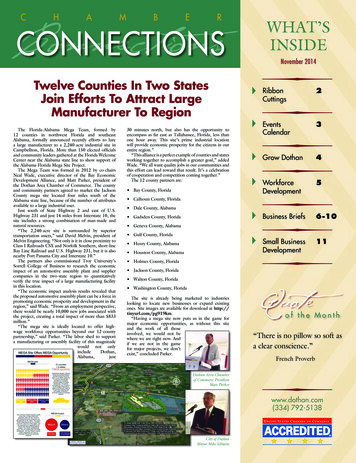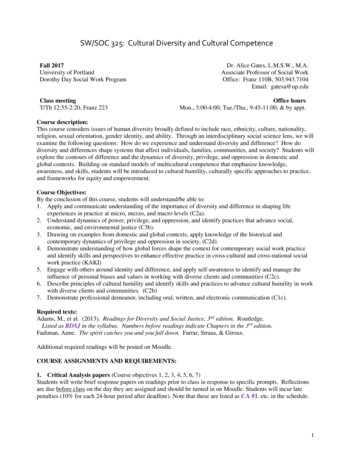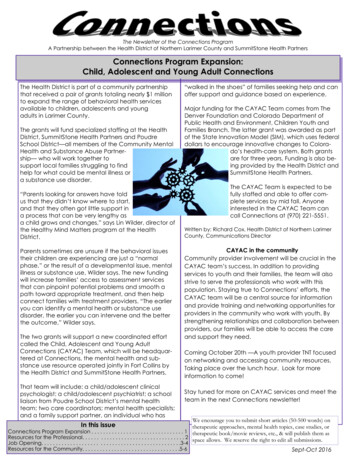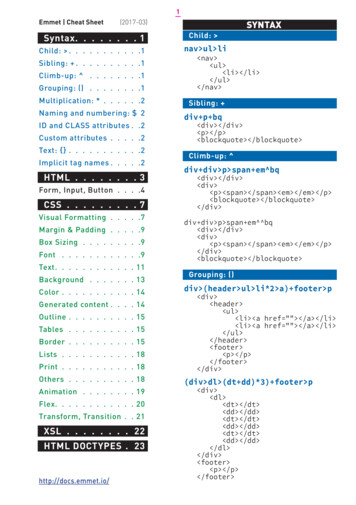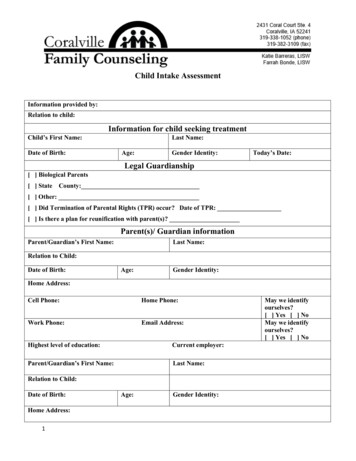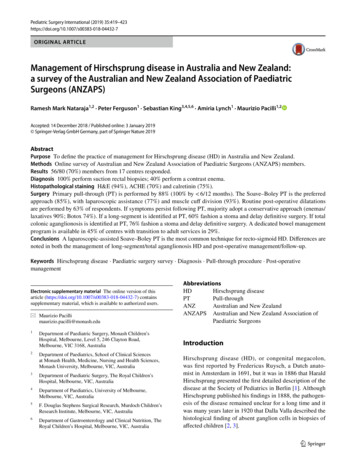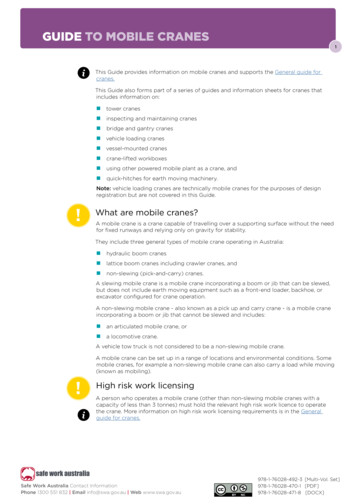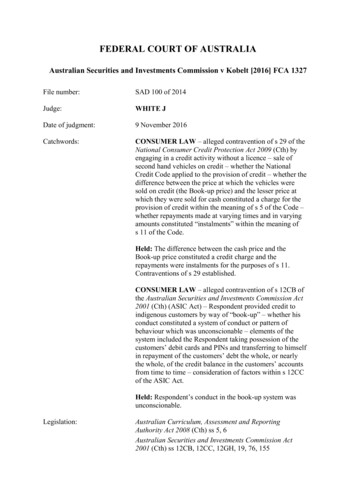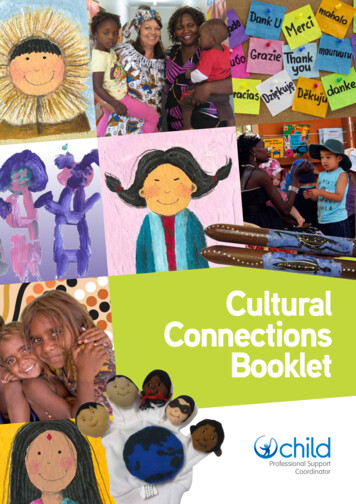
Transcription
CulturalConnectionsBookletProfessional SupportCoordinator
This cultural connections booklet has been created to complementand introduce some of the materials in your Cultural ConnectionsKit and to help you and your team engage in some of the key topicssurrounding ‘respect of diversity’ and ‘cultural competency’ in theearly child hood education and care sector.All of us want to ensure that the children and their families, whoattend our services, feel welcome, enriched and settled. Becauseof the rich diversity of our communities, it is important we supportchildren to be able to grow and flourish in a multicultural society.Cultural Connection Kits:In your kit you will find a variety of resources, including a mixture of: Puzzles Story books Puppets Dolls Games Musical Instruments Dress ups Cultural Treasure Chest DVD. Resource and Information sheetsHowever, cultural competency goes far beyond what resources wehave in our service. It’s about the relationships we make, the waywe connect with others and our attitudes.‘‘Often when we talk about ‘cultural competency’people often think where to get resources from, howto get Aboriginal people to come and tell stories, dodances, where to go to get puzzles and so on. What isimportant to stress is that this is secondary’ (Yorganop)Inside the booklet you will find a series of practical examples,stories, reflective questions and staff exercises. You will also seeideas on how to use the resources in your kit in a meaningful way.Some things that may be useful to bear in mind when using thisresource: Culture changes over time and members of different cultural orethnic groups will not always think and act in the same way Cultural considerations are relevant to all children, whether ornot their cultural identity is the same as the dominant culture As cultural competence is a reflection of combinations of whatwe know, what we want to know and what we can pass on,cultural competency becomes an integral part of a continuouslearning process Cultural competency is a life long journey, not a destination andit varies from moment to moment and from situation to situation.This resource focuses on cultural diversity in general. Clearly,Aboriginal and Torres Strait Islander people occupy a uniqueplace in our nation as the original custodians. While examples ofAboriginal and Torres Strait Islander experiences have been given,we strongly urge you to access materials and resources writtenby Indigenous organisations. A list of these can be found in theresource sections of this booklet.CulturalConnectionsBooklet
Table of ContentsIntroduction4What is Culture:5Cultural Competence68Environment& ResourcesRelationshipsSelfReflections of Diversity through the Curriculum7Where do I start?How do my biases affect the children I work with?Guiding children to respect diversity:Helpful tips in challenging discriminatory or bias comments from childrenJohari’s Window –revealing those blind spotsUnderstanding your own racism and personal prejudiceStaff Activity: A Refugee experienceQuestioning Our Assumptions And AttitudesStaff Activity: Cultural IcebergSome Key Differences Across CulturesFamily composition and parentingChild rearing practicesSpirituality, religion and other considerationsFood securityCelebrations, entertainment and religious observancesDecision municating With OthersExtended community involvementFirst Impressions & EnrolmentWorking With Families And Children Who Have English As Their Second LanguageBilingual language acquisition chart:Tips for when working with ESL FamiliesUsing interpretersResources3538394242444647What is TokenismStorytelling with children:Using puppets:ResourcesCommunity g Cultural & Linguistic Competency Self-Assessment ChecklistFootnotes51616168
4Cultural Connections BookletIntroductionResearch1 shows that: Children as young as 3 years old and sometimes earlier can show prejudice behaviour and attitudes. Evidence proves that children are affected by the attitudes and behaviours of adults around them. Educating children reduces discrimination and violence in society over the long term.It is at these early stages in their lives, where we as Educators can play a significantrole in planting seeds of tolerance, compassion and understanding that will contributetowards the creation of a more harmonious society for the future to come.‘Respect for diversity’ and ‘cultural competency’ are key aspects of the National QualityStandards (NQS), the Early Years Learning Framework (EYLF) and the Framework forSchool Aged Care (FSAC). There is also increasing evidence to show that supportingchildren to follow their cultural traditions and to participate in cultural activities enhancestheir wellbeing and can contribute to their resilience, social confidence and protectionfrom prolonged isolation, emotional trauma or exclusion.2Culture is ‘thefundamental buildingblock of identity’and is essential forchildren’s sense ofbeing and belonging.(Educators Guide EYLF2010, 21)Given that these topics are complex and cover such a vast array of areas, we havechosen to consolidate the research in the field and structure this resource into threekey areas: Self Relationships Environment & ResourcesThis symbol highlights how some of the resources in your Cultural Connection Kit arerelevant to the text.
5What is Culture:According to Aboriginal leader Dr. Alf Bamblett ‘culture is to people as water is to fish – we take ourown culture for granted as it is part of our identity and part of our very being’.(Aboriginal Cultural Competence Framework. Copyright State of Victoria 2008, Victoria Aboriginal Child CareAgency 2008).plee to peomohisAustralia 00 countries,yr2from ove hildren with manctproviding s to learn aboue’nitieopportu 3 owever, ‘cultur.Hn’sculturesa persootdeithois not lim It is related to ‘wy.’e.’4ethnicitidsinen thwe are o‘Cultural identity is not just anadd-on to the best interestsof the child .Your culturehelps define how you attach,how you express emotion,how you learn and how youstay healthy’.6dansmitte ge,rtiseruua‘Cultilies, langmfahguthroinies, withitnunemmcod from o 5nasniot’.generathe nextotniotagener’Educators who are culturallycompetent respect multipleways of knowing, seeing andliving, celebrate the benefitsof diversity and have anabilityto understand and honourdifferences (EYLF p.13)
6Cultural Connections BookletCultural CompetenceFor many educators, cultural competence is a new and perhaps unfamiliar area of focus. The EYLFdescribes cultural competence as:‘Much more than awareness of cultural differences. It is the ability to understand, communicate with, andeffectively interact with people across cultures’.7Cultural competence encompasses: Being aware of one’s own world view Developing positive attitudes towards cultural differences Gaining knowledge of different cultural practices and world views Developing skills for communication and interaction across cultures.The EYLF Educators Guide (2010, 25-26) describes cultural competency asa journey that encompasses skills, knowledge and attitudes. It highlights theneed for cultural competency to filtrate through three levels- the individual,the service level and the systems level.‘The ability to identify andchallenge one’s own culturalassumptions, one’s values andbeliefs. It is about developingempathy and connectedknowledge, the ability to see theworld through another’s eyes, orat the very least, to recognise thatothers may view the world throughdifferent cultural lenses.’8
7Reflections of Diversity throughthe CurriculumThe program should recognise and incorporate the diverse cultures,languages, beliefs and values of families, the community and children.Educators who are knowledgeable about the culture and languages thatchildren bring to school are then able to provide resources, experiencesand interactions that reflect children’s everyday lives. However, amulticultural approach is relevant regardless of whether the childrenare from diverse cultural backgrounds or not. Educators need towork consciously to assist children to recognise their own worldview andto build their competence to interact within cultures of larger society9.‘Being familiar with the rich and long history of Australia, including ourAboriginal and Torres Strait Islander histories and cultures is essentialand enriches us all.’ 10.‘Belonging, being and becoming areintegral parts of identity. Children learnabout themselves and construct theirown identity within the contexts of theirfamily and communities. This includesrelationships with people, places andthings and the actions and responsesof others. Identity is shaped byexperiences.’11
8Cultural Connections BookletSelf
SelfWhere do I start?‘Educators need to be aware that they pass on their personal values to the children in many ways, includingthrough the curriculum choices such as topics, language, activities, materials, celebrations, displays and intheir interactions with others.’12 ‘Omissions can be just as destructive as stereotypes and inaccurateinformation.’13 Therefore, educators need to firstly consider their own values, beliefs and attitudes relatedto diversity and acknowledge and address any bias they may hold (EYLF Educators Guide 2010)How do my biases affect the children I work with?Self-reflectionWhat way do we as Educators respond to discrimination?Think about how you and your service handle discrimination by checking out this list. Which ofthese approaches do you use most often?1. Head in the sand - We try to ignore discrimination and prejudice, our own and what’saround us.2. Giving out - We tell children what to think. We don’t really spend time discussing thingswith them.3. Making space - We help children explore what they think and feel as well as telling themour views.4. Getting support - We find out more about things we am unsure of, or unfamiliar with, bytalking, discussing, and finding out, so we get a clearer idea of where we stand.5. Seeing the big picture - We make links between our experiences and between differenttypes of prejudice and discrimination. We discuss these issues with the children.What might the results be of each approach?As Educators we may move between these different approaches in our everyday lives. Eachapproach has a different effect on your relationships and on the children’s development.1. Head in the sand - Children don’t learn to think about or deal with the issues (and areless likely to question what they hear from other people). Opportunities for buildingrelationships and learning are lost.2. Giving out - Children may feel that their viewsare not important and opportunities for buildingrelationships and skills are lost.3. Making space - Children develop skills, confidenceand conscience.4. Getting support - Educators develop skills,confidence and a clear understanding.5. Seeing the big picture - Children and educators areable to make links between their lives and the lives ofother people.Adapted by Connolly, P. (2002) Fairplay: Talking With Children About Prejudice andDiscrimination. Belfast: Barnardos and Save the Children.9
10Cultural Connections BookletGuiding children to respect diversity:‘Children need to be taught to respect, appreciate and positively interact with people who are differentfrom them. There are no simple solutions or easy answers to complex challenges such as discrimination,culture, prejudice or multiculturalism. Educators need to be committed to designing and implementingculturally relevant and enriching curriculum whilst teaching children to reject bias and stand up forthemselves and others who may be experiencing discrimination.’14“We may think that events happening in the world do not reach young children. But to the contrary, childrenif given the opportunity can raise issues that can appear very complex for discussion, such as racism.”15ExampleAn example of practice:‘A child from South Africa was talking to his friends about the apartheid and about Nelson Mandela.He was very aware of the unfairness of apartheid and its meaning. His friends, though interested,could not grasp the idea. They had no information or experience of it.I decided to do a short story where Sipho, the black South African doll, explained why his parentscame to live and study in Australia. After the story we ‘did apartheid’. We used the colour of eyesand long and short hair to re-create a situation where the children could talk about similarities anddifferences and what it can feel like to be treated differently. We talked about how it affected us, thethings we could do, the friends we could not have and the places we could not go, how we felt,and how fair or unfair it was. (Creaser, B and Dau, E. The Anti-bias Approach in Early Childhood1998, 168)The example above illustrates how an educator proactivelycame up with an activity to assist the children to furtherexplore the harmful effects of the apartheid. Theactivity created an experience for the childrento feel what it is like to be treated differently orunfairly. Such an activity can be effective, yetneeds to be facilitated carefully. For moreinformation visit www.janeelliott.comIt is not uncommon for us to feel discomfort whendealing with children’s ethnic and racial identityand bias.‘There is a tendency to ignore these issues, either in the hopethey will go away, or because of the mistaken notion that biasand prejudice is made worse by paying attention to it. Children’sconcerns and attitudes about ethnic and racial differences arereal and intense. You have a small window of opportunity toprevent these normal concerns and attitudes from becomingdeeply ingrained prejudices that are invulnerable it change.If you cannot truly engage children and deal directly with thiscontent, this opportunity is lost.’’ (Klein & Chen 2001,127)
SelfExampleBeauty- A white Fantasy:A study conduct
‘A child from South Africa was talking to his friends about the apartheid and about Nelson Mandela. He was very aware of the unfairness of apartheid and its meaning. His friends, though interested, could not grasp the idea. They had no information or experience of it. I decided to do a short story where Sipho, the black South African doll, explained why his parents came to live and study in .
